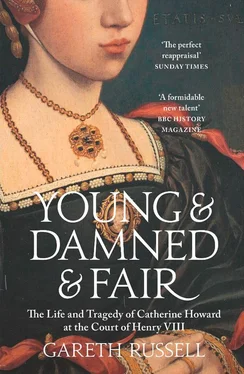The implosion of Catherine’s marriage was a very different affair. Three months were taken to determine her fate, Parliament was consulted, embassies were invited to send representatives to the trials of the queen’s co-accused, witnesses were fetched back for multiple rounds of questions, and a thorough agenda was set for each interrogation. So the interpretation of Anne Boleyn’s downfall as one in which a powerful but divisive queen consort was harried to her death with maximum speed, minimum honesty, and determined hatred has no bearing on her cousin’s fate five years later. What happened to Catherine Howard was monstrous and it struck many of her contemporaries as unnecessary, but it was not a lynching. The queen was toppled by a combination of bad luck, poor decisions, and the Henrician state’s determination to punish those who failed its king. A modern study of Henry’s marriages offered the conclusion that if ‘ever a butterfly was broken on the wheel, it must surely have been Catherine Howard’, and in the sense that the wheel in question was her husband’s government, there was an inexorable quality about the way it turned to crush Catherine after 2 November 1541.8
I have spelled Catherine’s name with a ‘C’ to differentiate her from other Katherines in a generation with many. Her name has been given as Katherine, Katharine, Catharine, and Kathryn in other biographies, and standardised spelling was never a sixteenth-century priority. For clarity’s sake, Catherine’s two stepdaughters are usually referred to here as princesses. Each sister had been styled as a princess from the time of her birth until the annulment of her mother’s marriage, after which they were both addressed by the honorific of ‘lady’, even when they were rehabilitated into the line of succession. During their brother’s reign, they were interchangeably referred to by both titles, owing to their positions as first and second in line to the throne, and Elizabeth was often referred to as Princess Elizabeth during Mary’s time as queen. To mark them out from the other Marys and Elizabeths, I have decided to err on the side of politesse in giving both women the higher title when they are mentioned in passing. For similar reasons, I have sometimes given the names of foreign princesses in their native language – hence Maria of Austria and Marie de Guise, rather than the anglicised Mary. Where possible, I have tried to be consistent – Maria of Austria was also known as Mary of Hungary, Catherine’s sister Isabella is Isabel in some sources. Likewise, the surnames of many of those involved in Catherine’s story vary – Culpepper is Culpeper; Dereham is given as Durham, Durant, or Deresham; Edgcumbe or Edgecombe; Habsburg or Hapsburg; Knyvet or Knyvett; Mannox, Manox or Mannock; Damport or Davenport. Where required, I have chosen a common spelling.
I have modernised the spelling in quotations from the original documents. All quotations from the Bible are taken either from the Douay-Rheims or King James editions. I have avoided giving estimations of modern equivalents to Tudor money, since they are often misleading and, at best, imprecise. Prior to 1752, England operated under the Julian calendar, and the new calendar year commenced on 25 March, the Feast of the Annunciation, rather than on 1 January. By our reckoning, Catherine Howard was executed on 13 February 1542, but her contemporaries in England would have given 1541 as the year of her death. Almost all historians give the modern dating and I have followed suit.
Chapter 1

Renounce the thought of greatness, tread on fate,
Sigh out a lamentable tale of things
Done long ago, and ill done; and when sighs
Are wearied, piece up what remains behind
With weeping eyes, and hearts that bleed to death.
– John Ford, The Lover’s Melancholy (1628)
A benefit of being executed was that one avoided any chance of the dreaded mors improvisa , a sudden death by which a Christian soul might be denied the opportunity to make their peace. So when Thomas Cromwell was led out to his death on 28 July 1540, he had the comfort of knowing that he had been granted the privilege of preparing to stand in the presence of the Almighty. The day was sweltering, one in a summer so hot and so dry that no rain fell on the kingdom from spring until the end of September, but the bulky hard-bitten man from Putney who had become the king’s most trusted confidant and then his chief minister1 walked cheerfully towards the scaffold.2 He even called out to members of the crowd and comforted his nervous fellow prisoner Walter, Lord Hungerford, whose sanity was questionable, and who had been condemned to die alongside him for four crimes, all of which carried the death penalty. Firstly, he had allegedly committed heresy, in appointing as his private chaplain a priest rumoured to remain loyal to the pope. Secondly, he was accused of witchcraft, by consorting with various individuals, including one named ‘Mother Roche’, to use necromancy to guess the date of the king’s death. Treason was alleged through the appointment of his chaplain and his meeting with the witch, which constituted a crime against the king’s majesty. He was also found guilty of sodomy, ‘the abominable and detestable vice and sin of buggery’, made a capital crime in 1534, in going to bed with two of his male servants, men called William Master and Thomas Smith.3
Rumours, fermenting in the baking heat and passed between courtiers, servants, merchants and diplomats who had nothing to do but sweat and trade in secrets, had already enlarged the scope of Lord Hungerford’s crimes. The French ambassador reported back to Paris that the condemned man had also been guilty of sexually assaulting his own daughter. It was whispered that Hungerford had practised black magic, violating the laws of Holy Church that prohibited sorcery as a link to the Devil. Others heard that Hungerford’s true crime had been actively plotting the murder of the king.4 None of those charges were ever mentioned in the indictments levelled against Hungerford at his trial, but the man dying alongside him had perfected this tactic of smearing a victim with a confusing mélange of moral turpitudes guaranteed to excite prurient speculation and kill a person’s reputation before anyone was tempted to raise a voice in their defence.
The hill where they now stood had been the site of the finales to some of Cromwell’s worst character assassinations. It had been there, four years earlier on another summer’s day, that George Boleyn had perished before similarly large crowds after Cromwell arranged a trial that saw him condemned to death on charges of incest and treason. The details of Boleyn’s alleged treason had been kept deliberately vague during the trial, while the prosecution’s fanciful descriptions of his incestuous seduction of his sister had been excruciatingly, pornographically vivid. Boleyn, as handsome as Adonis and proud as Icarus, had defended himself so well against the accusations there had been bets that he would be acquitted.5 When he was not, when he was condemned to die alongside four other men two days later, no one could risk speaking out for a man found guilty of committing such a bestial act.
Boleyn had died in sight of the Tower’s brooding walls, its cupolas and fortifications twin testaments to the inescapably neurotic nature of power. Within the Tower’s sheltered courtyards, George’s Boleyn’s sister, Queen Anne, was executed in a more private setting, before a carefully vetted crowd of around one thousand, which was tiny in comparison to that allowed to gather beyond the walls to watch her brother perish – and now Cromwell and Walter Hungerford.6 Like Thomas More before her, another political heavyweight in whose destruction Cromwell had been intimately involved, Anne Boleyn had embraced the sixteenth century’s veneration for the ars moriendi – the art of dying.
Читать дальше












![John Bruce - The Lettsomian Lectures on Diseases and Disorders of the Heart and Arteries in Middle and Advanced Life [1900-1901]](/books/749387/john-bruce-the-lettsomian-lectures-on-diseases-and-disorders-of-the-heart-and-arteries-in-middle-and-advanced-life-1900-1901-thumb.webp)
